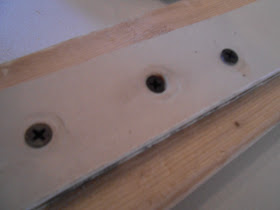All right, listen up, Besties, today we start the fun part.
We destroyed the house.
Now, it's time to put it back together!
And to do that, we need a truck load of walls!
So let's load the prurient parts on a rented truck and go at it like guests on Jerry Springer!
This is, of course
Everything You Ever Wanted to Know About Hard Core Remodeling but Were Afraid to Ask!
And I drove the truck!
We need to start with the basics.
We'll need insulation.
This is rated R-13, a perfect grade for walls.
We chose a fiberglass free product so no one would have to handle it carefully.

Drywall is made out of gypsum, a word which may not mean
much to you.
Gypsum itself is made out of the chemical calcium sulfate, a
common mineral that occurs naturally in the earth. To form drywall,
manufacturers add additional ingredients
that make the drywall
construction worthy.
Drywall is mixed wet, wrapped in heavy paper, then fired in a
large kiln to dry.
The resulting board is only semi-flexible, quite
firm and somewhat water-permeable.
This is green board, which is for bathrooms and other high moisture areas.
And THIS is a chalk line.
The body of this baby is refillable with powdered chalk.
And this is what it does.
You measure the wallboard, put the chalk line on either side of the board,
pull it taut, and SNAP!
Instant straight line.
This is a drywall T-square.
It helps you make nice 90 degree angles.
It helps you make nice 90 degree angles.
So once you have measured, and have your chalk line snapped, take a blade and cut through the paper
of the drywall.
of the drywall.
This puppy is a rasp.
Any uneven or ragged edges can be cleaned up easily.
Any uneven or ragged edges can be cleaned up easily.
It's kind if like a cheese grater for drywall.
And THIS is a drywall driver.
It helps you select the depth at which you want the screws to sink.
It helps you select the depth at which you want the screws to sink.
Why is this important?
Simple.
As I said, drywall is sandwiched between two layers of paper.
Believe it or not, that paper is load bearing.
We don't want to break it, tear it, harass it, miff it, disturb it, perturb it, confuse it,
overuse it, or lose it.
Believe it or not, that paper is load bearing.
We don't want to break it, tear it, harass it, miff it, disturb it, perturb it, confuse it,
overuse it, or lose it.
When you sink a drywall screw, you want it below the surface,
with a dimple in the paper.
with a dimple in the paper.
See that?
We took a scrap piece and a bit of leftover lumber and practiced.
Minion #3 was all over it.
Still scared?
Relax.
It just takes a couple of tries.
Relax.
It just takes a couple of tries.
Okay, she's got it.
Minion #1 was a duck to water.
Of course The Redhead got in there.
I have an unfair advantage of course, since I've done this before.
The end is magnetic, so the idea is to set the screw in place and just drill straight in.
Keep your tool perpendicular, and you're going to be perfect.
"What? What do you mean I messed up? You're high."
Monday, let's get this stuff on the wall!
Monday, let's get this stuff on the wall!
































You drove the truck? You are awesome.
ReplyDelete